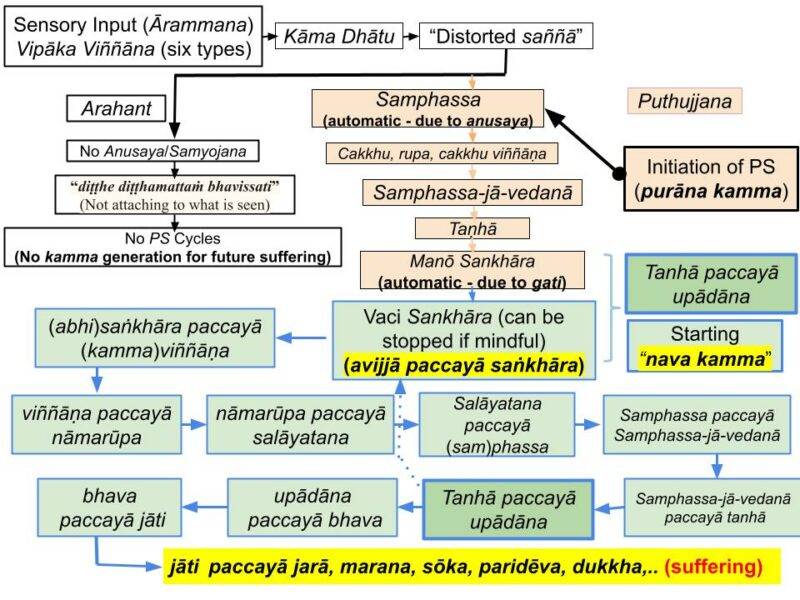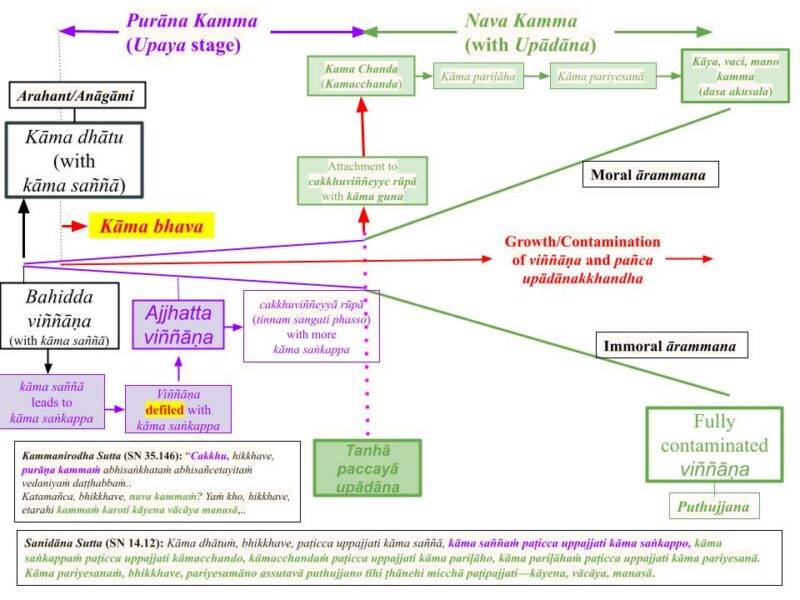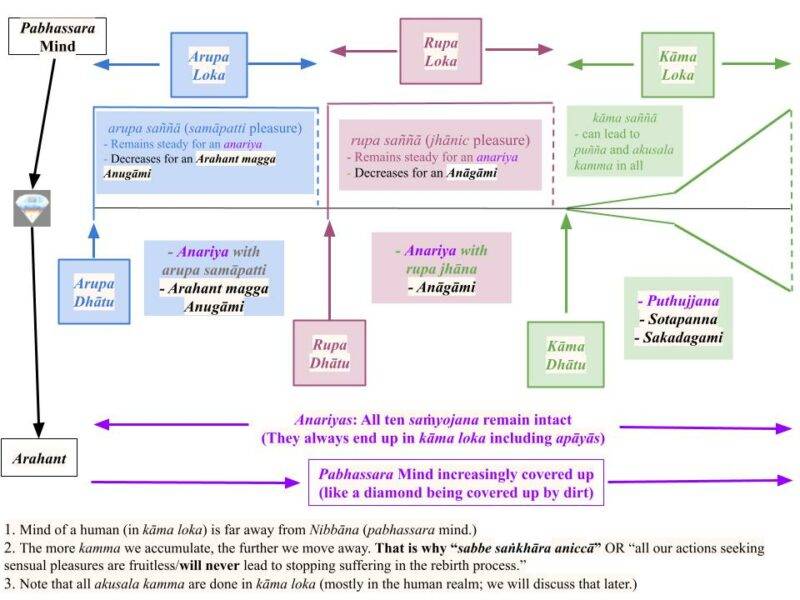A Paṭicca Samuppāda cycle starts at the “purāna kamma” stage with Avyākata Paṭicca Samuppāda. However, new and robust kamma (that could lead to rebirths in the future) is done in the “nava kamma” stage (via Akusala-Mula Paṭicca Samuppāda) only if the mind starts generating vaci and kāya kamma consciously.
January 11, 2024; revised June 24, 2024
Introduction
1. Kamma accumulation happens in two distinctive stages.
- In the first stage, the mind of a puthujjana attaches automatically to sensory input ( ārammaṇa) based on the “distorted saññā” we discussed in recent posts. That attachment is due to “saññā vipallāsa.” Thus, “saññā vipallāsa” arises ONLY IF “fooled by the distorted saññā”; see “Fooled by Distorted Saññā (Sañjānāti) – Origin of Attachment (Taṇhā).”
- Of course, a mind must at least briefly become aware of the ārammaṇa—many sensory inputs “fly by” without us noticing them. If the mind becomes sufficiently interested in the sensory input, it will start the second stage of kamma accumulation with javana cittās.
- Any sensory experience with at least (i) above will be registered as “pañcupādānakkhandha,” and a record of it (namagotta) will be preserved in viññāṇa dhātu (in the external world.) Note that those records DO NOT stay with the hadaya vatthu or gandhabba. The gandhabba (in a physical body) must retrieve memories from the viññāṇa dhātu via the brain. See “Where Are Memories Stored? – Viññāṇa Dhātu.” Only the defilements” (anusaya, saṁyojana, gati, etc. are associated with the hadaya vatthu/gandhabba.)
Purāna and Nava Kamma Stages of a Sensory Event
2. Therefore, the first attachment stage ALWAYS happens (at the “purāna kamma” stage.) Kamma (with initial abhisaṅkhāra) happens in this stage but is not strong enough to bring vipāka in the future. Yet it initiates another round of pañca upādānakkhandha.
- Therefore, a mind (sensory event) NEVER starts from the pañcakkhandha state for anyone below an Arahant. The pabhassara mind arises only after all ten saṁyojana are removed from the mind (i.e., hadaya vatthu) at the Arahant-phala moment.
- If the second stage attachment (“nava kamma” stage) does not take place, no javana cittās will arise. Strong kamma that can bring future vipāka (including rebirth) will occur only if javana cittas arise within the “nava kamma” stage.
3. On this website, up to now, we had mainly discussed the “nava kamma” stage. However, I used that term only in recent posts when I first introduced the “purāna kamma” stage briefly.
- We have discussed the concepts of the following chart previously without using the terms “purāna kamma” and “nava kamma.“

Download/Print: “Purāna and Nava Kamma – 1“
- For example, a similar chart is in “Difference Between Tanhā and Upādāna.” But the above chart has far more details.
Purāna Kamma Stage
4. “Purāna kamma” can be translated as “initial kamma” or “base-level of kamma generation.”
- That stage happens automatically based on the “distorted saññā.” As we have discussed, anyone born with a human body ALWAYS gets a “made-up” version of sensory input (altered by the “distorted saññā.”)
- A Paṭicca Samuppāda (PS) process always starts with an ārammaṇa. The chart below shows how a cakkhu viññāṇa starts with a rupa (visual) as a sensory input. A sensory event starts on the left at the “dhātu stage.” While the mind of an Arahant stops there, that of a puthujjana keeps evolving to the right, becoming increasingly defiled.

Download/Print: “Purāna and Nava Kamma – 2- revised“
- (I adopted the “cone representation” of the “expansion of viññāṇa” from the Sinhala discourse series “බුදු දහම, මාර්ග ඵල සහ මග වැඩීම.”; I highly recommend it for a Sinhala-speaking audience.)
Bahidda and Ajjhatta Viññāṇa
5. Kamma viññāṇa of a puthujjana starts right after the kāma dhātu stage when the mind automatically attaches to the “distorted saññā” due to the “hidden defilements” (anusaya/saṁyojana.) That happens with saṅkappa (only mano saṅkhārā) in the first citta vithi.
- That first attachment is where the “altered rupa” with “distorted saññā” is presented to the mind, and the mind generates the first stage of viññāṇa (vipāka viññāṇa) called “bahidda viññāṇa.” Note that this “distorted saññā” is imparted via the physical body (and the brain.) Thus, an Arahant would also experience that “altered rupa” or “bahidda viññāṇa.” However, an Arahant (or an Anāgāmi, also free of kāma loka) would not attach to it.
- The following steps are for anyone below the Arahant or Anāgāmi stages.
- In the next step, the mind attaches again with more saṅkappa (taking the bahidda viññāṇa to be valuable), which leads to the use of cakkhu indriya as an āyatana; thus, from now on in the process, “cakkhu” refers to “cakkhu āyatana.” The viññāṇa is stronger and at the “ajjhatta viññāṇa” stage.
6. “Kammanirodha Sutta (SN 35.146)“: “Cakkhu, bhikkhave, purāṇa kammaṁ abhisaṅkhataṁ abhisañcetayitaṁ vedaniyaṁ daṭṭhabbaṁ..
Translated: “Cakkhu arises via purāṇa kamma. It is to be understood (daṭṭhabbaṁ) to lead to abhisaṅkhāra (abhisaṅkhataṁ) and can lead to abhisañcetanā (abhisañcetayitaṁ) and leads to (mind-made) vedanā (vedaniyaṁ.)
- When seeing an object, “Eye consciousness arises based on cakkhu and rūpa” OR “Cakkhuñca paṭicca rūpe ca uppajjati cakkhu viññāṇaṁ.” At this step, cakkhu viññāṇa is already at the “ajjhatta viññāṇa” stage (However, for an Arahant or Anāgāmi, it remains at the bahidda viññāṇa stage.)
- Here, “cakkhu” does not mean “eyes;” it means defiled “cakkhu āyatana” (versus undefiled “cakkhu indriya” for an Arahant/Anāgāmi.) That is precisely what the above verse says: It has already been defiled when the mind got contaminated by the “distorted saññā” when it moved from the “kāma dhātu” stage to the “kāma bhava.”
- This is depicted in the second chart above.
Bahidda Viññāṇa Arises Due to “Distorted Saññā“
7. Anyone born a puthujjana will have the physical body born with the “distorted saññā.” Thus, the “rupa” coming to the mind is not a true representation of the external rupa but has the “distorted saññā.” Thus, even an Arahant/Anāgāmi would taste sugar to be sweet. This is not a “superficial trick” by a third-rate magician but a “sophisticated trick” that can be uncovered only by a Buddha. A human body is designed (by kammic influence) to provide that “attractive saññā” because those born humans had craved them in past lives.
- For example, see #5 and #6 of “Vedanā (Feelings) Arise in Two Ways.”
- The primary reason for our tendency to indulge in sensual pleasures is this “distorted and made-up saññā.” See “Kāma Rāga Arises Due to “Distorted Saññā” (Note: “distorted saññā” leads to “saññā vipallāsa” ONLY for those not comprehending how that “trick” plays out.)
- Many people incorrectly think they must remove kāma raga from their minds by willpower. That could make things worse by becoming an “unhappy person.” On the other hand, once one comprehends that there is no intrinsic “sweetness in sugar” or “beauty of a woman,” it is much easier to get rid of kāma raga.
Root Cause of Attachment – “Distorted Saññā“
8. As we can see in the above chart, this “distorted saññā” is the root cause of our attachment to “attractive sensory inputs.” When we try to get “more of such made-up enjoyments,” we engage in akusala kamma that bring us “unintended harmful consequences (kamma vipāka),” including rebirth in suffering-filled realms (like the animal realm.)
- Enjoying “sensory pleasures” is like watching a good magic show. That is why the Buddha called viññāṇa a “magician.”
- I have emphasized this in many recent posts because it is a critical point: “Mūlapariyāya Sutta – The Root of All Things.”
- We accumulate such akusala kamma in two stages. The first “subtle stage” is the “purāna kamma stage,” when kamma accumulation starts at a subtle level that our minds are unaware of.
- If the mind sufficiently attaches to the sensory input, we consciously start accumulating new, strong kamma with speech and actions based on vaci and kāya saṅkhārā. As shown in the first chart above, that happens at the “taṇhā paccayā upādāna” step in the Akusala-Mula Paṭicca Samuppāda process. That is the “nava kamma” stage.
Nava Kamma Stage
9. Kammanirodha Sutta (SN 35.146): Katamañca, bhikkhave, nava kammaṁ? Yaṁ kho, hikkhave, etarahi kammaṁ karoti kāyena vācāya manasā,..
- The second chart above shows how a mind gets defiled in real-time by repeatedly attaching to a sensory input (we assume a visual input.)
- The mind of anyone born a human (including an Arahant) starts at the kāma dhātu stage. That physical body (and the brain) will automatically present to the mind an “altered rupa” instead of a “true representation of the external rupa.” That is why a “distorted saññā” (e.g., the sweetness of sugar) arises in an Arahant as well as for a puthujjana.
- However, the mind of an Arahant would not attach to that “altered rupa” because that mind has fully grasped how that “trick” takes place, as explained in the above charts.
General Attachment Sequence for Kāma Dhātu
10. The “Sanidāna Sutta (SN 14.12)“ points out the general sequence of steps involved in kamma accumulation based on any sensory input in kāma loka. We discussed that in the post “Upaya and Upādāna – Two Stages of Attachment.”
- “Kāma dhātuṁ, bhikkhave, paṭicca uppajjati kāma saññā, kāma saññaṁ paṭicca uppajjati kāma saṅkappo, kāma saṅkappaṁ paṭicca uppajjati kāmacchando, kāmacchandaṁ paṭicca uppajjati kāma pariḷāho, kāma pariḷāhaṁ paṭicca uppajjati kāma pariyesanā.” OR “Attachment to kāma dhātu leads to kāma saññā, attachment to kāma saññā leads to kāma saṅkappa, attachment to kāma saṅkappa leads to kāmacchanda..and so on to kāma pariyesanā.“
11. In the post “Contamination of a Human Mind – Detailed Analysis,” we discussed the following verse in the “Saññānānatta Sutta (SN 14.7),” which discusses the six types of sensory inputs available in the kāma loka. Thus, it expended the general statement in the above verse:
“Rūpa dhātuṁ, bhikkhave, paṭicca uppajjati rūpa saññā, rūpa saññaṁ paṭicca uppajjati rūpa saṅkappo, rūpa saṅkappaṁ paṭicca uppajjati rūpacchando, rūpacchandaṁ paṭicca uppajjati rūpa pariḷāho, rūpa pariḷāhaṁ paṭicca uppajjati rūpa pariyesanā” OR “Rūpa dhātu gives rise to the perception of that sight (rūpa saññā.) That perception (if mind-attaching) gives rise to thoughts about it (rūpa saṅkappa.) Thoughts give rise to the desire for such sights (rūpacchanda.) The desire for sights gives rise to the passion for sights (rūpa pariḷāha.) The passion for sights gives rise to pursuing/investigating sights (rūpa pariyesanā.) In the last one, “pariyesanā” means “investigations;” when one becomes interested in something, one investigates how to use it optimally.
- Then the verse is repeated for all SIX senses ending with “dhamma dhātuṁ paṭicca uppajjati dhamma saññā, dhamma saññaṁ paṭicca uppajjati dhamma saṅkappo, dhamma saṅkappaṁ paṭicca uppajjati dhammacchando, dhammacchandaṁ paṭicca uppajjati dhamma pariḷāho, dhammapariḷāhaṁ paṭicca uppajjati dhamma pariyesanā.”
Broader View Including All Realms
12. The second chart above explains the effect of the “distorted saññā” on initiating the defilement of the mind (i.e., the growth of “kamma viññāṇa” or the “pañca upādānakkhandha“) in the kāma loka. In fact, it takes place mainly in the human realm.
- A somewhat similar “distorted saññā” also arises in the 16 realms of the rupa loka (rupāvacara Brahma realms) and the four realms in the arupa loka (arupāvacara Brahma realms.) However, “kamma accumulation” DOES NOT happen significantly in those realms.
- An anariya yogi born in any of those 20 realms will experience the “jhānic/samāpatti sukha” until the end of their lifetime there. Then, they will be reborn in the kāma loka.
- An Ariya born in one of those realms will also experience the “jhānic/samāpatti sukha,” which ALSO arises from “distorted saññā.” However, they will again remove attachment to that “distorted saññā” and advance to the higher realms, eventually reaching Arahanthood.
- That is explained in the chart below.
Sabbe Saṅkhārā Aniccā

Download/Print: “Purāna and Nava Kamma -3“
13. A mind MUST first fall on one of the three dhātus (upon receiving an ārammaṇa.) Those in rupa or arupa loka cannot receive “sensual sensory inputs” (because they don’t have dense bodies), so their minds fall on either the “rupa dhātu” or the “arupa dhātu.”
- For example, anariya Brahma in a “rupa loka Brahma realm” only receives the “distorted saññā” of “rupāvacara jhānic sukha” and will automatically attach to it with “saññā vipallāsa.” They do not accumulate more kamma but will return to kāma loka at the end of Brahma‘s life. Unlike in the kāma loka, there is no way to accumulate (strong) kamma in the rupa or arupa Brahma realms.
- An Anāgāmi in rupa loka will also get the “distorted saññā” of “rupāvacara jhānic sukha” but can see the “anicca nature” of that saññā and can stop attaching to it.
14. Therefore, an anariya‘s mind can never move toward the “suffering-free pabhassara mind.” That is the crucial point to be seen from the above third chart.
- In particular, ANY action, speech, or thought of a human puthujjana will ALWAYS move their minds AWAY from the “suffering-free” pabhassara mind. That is a key reason why the abhisaṅkhāra generation (via “avijjā paccayā saṅkhārā“) is of the “anicca nature.” In other words, “sabbe saṅkhārā aniccā.”
- That also means the mind of a puthujjana NEVER moves in the “parināmi” direction or “for the better.” It always moves in the “viparināmi” or “for the worse.”
- That is discussed in the post “Aniccaṁ Vipariṇāmi Aññathābhāvi – A Critical Verse.“
Purāna and Nava Kamma Stages – Connection to Paṭicca Samuppāda
15. As you may be able to see, the purāna and nava kamma stages correspond to the Avyākata Paṭicca Samuppāda and Akusala-Mula Paṭicca Samuppāda processes respectively.
- For details, see “Avyākata Paṭicca Samuppāda for Vipāka Viññāṇa.”
- Also see “Upaya and Upādāna – Two Stages of Attachment.”
- In the Sutta Piṭaka, the above two PS processes are treated together as just “Paṭicca Samuppāda.” The separation into two distinct processes is seen only in the Commentaries.
16. All related posts in “Sotapanna Stage via Understanding Perception (Saññā).”

